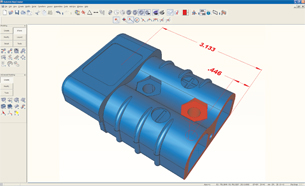Latest News
March 2, 2009
By Mike Hudspeth
 Figure 1: In a surface modeler the outside geometry is king. There is little concern about anything else. Surface modelers are generally explicit modelers. Image courtesy of Alias |
We’ve all been around the block a time or two and seen some odd pairings. Take Michael Jackson and Lisa Marie Presley.
Now, they say opposites attract, but these two were from totally different worlds. The thing about opposites is you have to have some common points of reference or it’ll never work out. There are just so many obstacles otherwise. Kind of like explicit (or direct) and parametric modeling.
Can they work together? Should they? I say, why not.
Does History Matter?
At the dawn of modeling time, the only way to model was by explicit means. 3D modeling consisted of wireframes. If you’ve ever seen the original Star Wars you’ve seen what I mean. The graphic briefing for the rebel pilots in that 1977 film was generated on computers of that era—at the time they were the state of the art. Conspicuously absent was any kind of shading whatsoever.
A few years later, surface modeling came to be and it was the new way things were done. It offered massive advantages over wireframe modeling. For one, you could really get accurate intersection curves— something that was very difficult without surfaces—where a boss meets a wall or a hole goes through a face.
 Figure 2: When you import a model from another program you sometimes get open holes. Explicit modelers are generally better equipped to handle imported geometry. Figure 2: When you import a model from another program you sometimes get open holes. Explicit modelers are generally better equipped to handle imported geometry. |
Autodesk’s Alias is a good example (see Figure 1) and became the preeminent industrial design software because you could model literally anything you could imagine. For the same reason (and small file sizes), surfacing programs are still the leader in the entertainment and gaming industries. Yet improvements were still needed. Everything you did with surfaces was tedious. You had to worry about how accurate the surface edges were. If they didn’t meet within the right tolerances, you’d have gaping holes in your models and they wouldn’t be “watertight” (see Figure 2).
Things improved when solids made their debut and the world of product design hasn’t been the same since. The advantage of solids over surfaces is that the computer knows the inside of the model from the outside.
A good working definition of a solid is simply a fully enclosed volume. If you take a collection of surfaces that are watertight and sew them together, you end up with a solid. With a solid you don’t usually have to worry about turning your model inside out, which is most disconcerting. Many were the times that it happened to me (don’t ask me how—it seemed different each time).
Another advantage with solids is a reduced set of steps to create things. With surfaces, you had to model each and every surface and trim it to its intersections. In a solid modeler, you just sweep the solid and it knows where everything ends. If you have to put a blend on an edge of a cube, you just pick the edge and plug in a radius instead of creating a radius surface and then trimming all four edges of the radius surface as well as the four cube surfaces. (Of course to be fair, most modern surface modelers now do most of the trimming for you.)
Then came feature modeling. Before then, anything you did was its own beginning and end. What it was was what it was and that was that. But with feature modeling you preserve what you do to create your geometry. A feature is very much like a macro that builds a particular kind to geometry. Say, for instance, you want to build a boss on a surface. You tell the computer you want to build a boss, where you want it to be, how tall it will be, and what the diameters are top and bottom. You might even control it by the angle on the sides of the boss. The computer will know what to do. It’s a breeze.
 Figure 3: If you don’t set up your constraints to control what you want to change you will sometimes get wild results. This sketch, if extruded or revolved as is, will result in a modeling problem. Figure 3: If you don’t set up your constraints to control what you want to change you will sometimes get wild results. This sketch, if extruded or revolved as is, will result in a modeling problem. |
Parametrics Remembers
Everything up to this point can be considered explicit modeling (although you could argue that feature modeling isn’t). You see, all the information you enter is directly related to what you are doing at that moment. The real downside to explicit modeling is that it’s much like a photocopier. It forgets everything as it creates it. There’s no real history. Enter parametrics.
Parametric modeling is a lot like explicit modeling at its beginning but quickly diverges. You create construction geometry from which your features and models are derived. The main difference is that your features stay related to their creation curves. That allows you to make changes to your features by tweaking their creation curves.Parametric modelers force you to create what are called sketches. These are collections of mostly planar geometry that you use to create your model. You can create surfaces or solids this way. The majority of modern solid modelers use sketches and parametrics of some kind. The first widely accepted parametric modeler to blaze the history trail was Pro/ENGINEER from PTC.
Where sketches are different from explicit modeling is that you can add constraints (see Figure 3). There are two types of constraints you can apply: geometric and dimensional.
Geometric constraints dictate things like: this line will always be parallel to that one or this circle will always remain concentric to that circle. They are very handy for alignment. You can make sure a line lies in exactly the same orientation as another edge—even though neither ever actually touches the other.
Dimensional constraints—as their name suggests—apply dimensions to your sketch geometry. You can tell the geometry to always be exactly so long and—no matter what changes you make—it will remain that length. You can even set up formulas. Say, for instance, you want the length of your sketch to always be one third its width. You can do that, too.
So Which One is Better?
That depends. What are your goals? What do you want to do with your models? Where will they go and what will you want them to do when they get there? Let these things dictate what methods you use.
Explicit modelers are great for legacy data—especially that which comes in from differing 3D modelers. Such geometry rarely translates into your modeling software with its constraints intact. There are various reasons for that. (I often wonder if it has to do with vendors who really don’t want to make it easy for you to change your modeling software.) Generally, when you import (or open) geometry it’s what you see is what you get (WYSIWYG). Most translators deal with the exterior topology of the imported model only. That can be good for sending data to an outside vendor. You might trust them to do work for you, but don’t want them to have your original file with its built-in intelligence.
I may get some argument about this, but I see explicit modeling as inherently more secure than parametric. You can export it in whatever resolution you want. Yes, you can do that with parametric modelers, but explicit modelers start out with less intelligence in the first place.
One of the best uses of explicit modelers is in the concept arena. Explicit modeling is faster and easier to understand. If you don’t like something, lop it off and replace it. This method is often called hack and slash. If you deal with one-off models that must be completed in a short amount of time, explicit modeling might shine for you. There is no faster way to build or edit a model.
Before one of my former employers bought into the digital design stream, everything we did was by hand. The guys we had in our model shop were bonafide wizards at hands-on physical modeling. If they needed to soften a blend on a corner they just took a rasp and filed it down. Explicit modeling is as close as you can get to that level of intuitive approach. This is why editing an explicit model is blazingly fast.
Of course, parametric modelers offer their own set of advantages: unparalleled repeatability and control. When set up correctly you can reproduce any model and establish an entire product line easily. If you make families of parts, parametric modelers are superb. You can build models that are identical but for the length or width, or any other attribute.
You can set up design tables that control whatever parameters you want—often from an Excel spreadsheet. Editing a parametric file can be a real plus—again, if it’s set up right. You can really make a lot of changes just by altering one or two key dimensions. You can even delete your constraints and re-constrain your sketch in a completely different manner to get better results. Re-imagining your models is probably the most important advantage of a history-based system.
 Figure 4: Constraints keep things where you put them. Dimensional constraints tell you how tall, what diameter, or at what angle things are. By the way, some explicit modelers are now using constraints. Image courtesy of Kubotek USA Figure 4: Constraints keep things where you put them. Dimensional constraints tell you how tall, what diameter, or at what angle things are. By the way, some explicit modelers are now using constraints. Image courtesy of Kubotek USA |
Parametric modeling is all about relationships. How does one piece of geometry relate to others? You tell each piece of geometry how it is to perform. You set things up to act in a prescribed way. The advantage with parametrics is that your model will always act in a predictable manner—a manner you control. If you want to change the angle of a part on your model, you can just go into the sketch and change the angle dimension. If you’ve set the constraints appropriately, the angle will change just as you’d expect it to. (If you haven’t set things up right, it will probably let you know in the most en- tertaining of ways—entertaining for your
co-workers, that is (see Figure 4).)
Think of it the way you would in assembly modeling. If you don’t constrain a linkage to always act like a linkage, when you go to move the assembly through its range of motion, the linkage will do unpredictable things. The disadvantage in parametrics is that you must spend time—sometimes a considerable amount of time—up front setting up your parameters.
Was DaVinci a Genius?
Nowadays, the argument over explicit or parametric is somewhat academic. Explicit modelers are beginning to use some very parametric-like functionality and parametric modelers are offering explicit ways to get things done (see Figure 5).
 Figure 5: Just as some explicit modelers use constraints, some parametric modelers can do some very explicit things—like dragging a collection of faces. Image courtesy of Siemens PLM Software Figure 5: Just as some explicit modelers use constraints, some parametric modelers can do some very explicit things—like dragging a collection of faces. Image courtesy of Siemens PLM Software |
A great approach to take when modeling is the “renaissance” way. What do I mean by that? Think of Leonardo DaVinci. He had his hands into just about everything he could get into. He worked to discover and master as much as he could. The result was that he was way before his time in many of the things he thought up. You can be like that too. Learn several ways of doing the same things—learn each method’s ins and outs. That way you will know not only which technique works best for a given situation but why.
As with anything, a guru of an explicit or a parametric persuasion will always be able to model faster and better than a novice or casual modeler. It takes a 3D modeling guru to take a renaissance approach. We should aspire to that.
From the beginning of my modeling career, I’ve chosen carefully the methods I’ve used. You should use the techniques that will get the results you want in the most versatile manner. Build in as much flexibility as you can. If that means explicit, go for it! If that takes parametric, dive in! Remember, you are building your modeling legacy. You will be known for the quality of the models you build. Do yourself—and everyone else—a favor. Don’t allow yourself to become limited in one way of doing things. Know your tools, and choose wisely.
More Info:
Autodesk
San Rafael, CA
PTC
Needham, MA
Mike Hudspeth, IDSA, is a senior designer for a global medical company and has been using a wide range of CAD products for more than 20 years. He, his wife, two daughters, and their cats live outside of St. Louis, MO. Send him an e-mail about this article to de-editors@digitaleng.news.
Subscribe to our FREE magazine, FREE email newsletters or both!
Latest News






